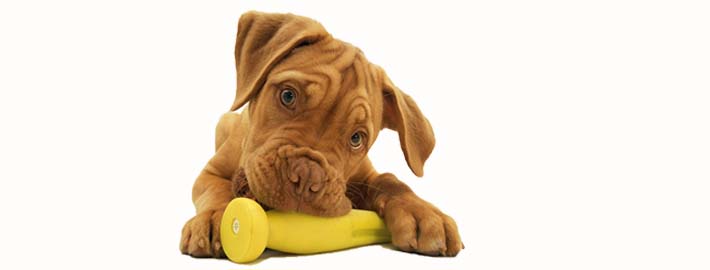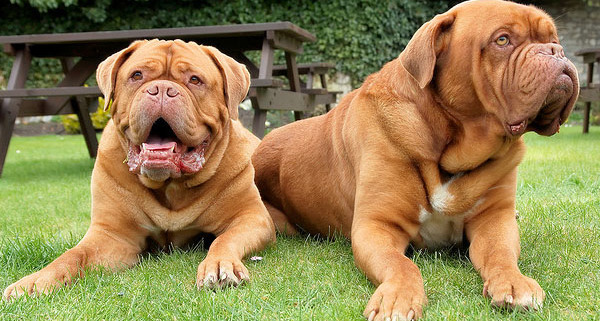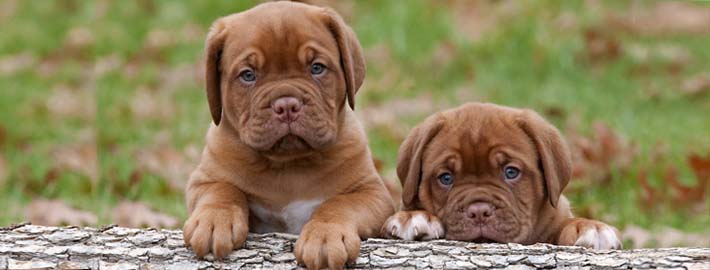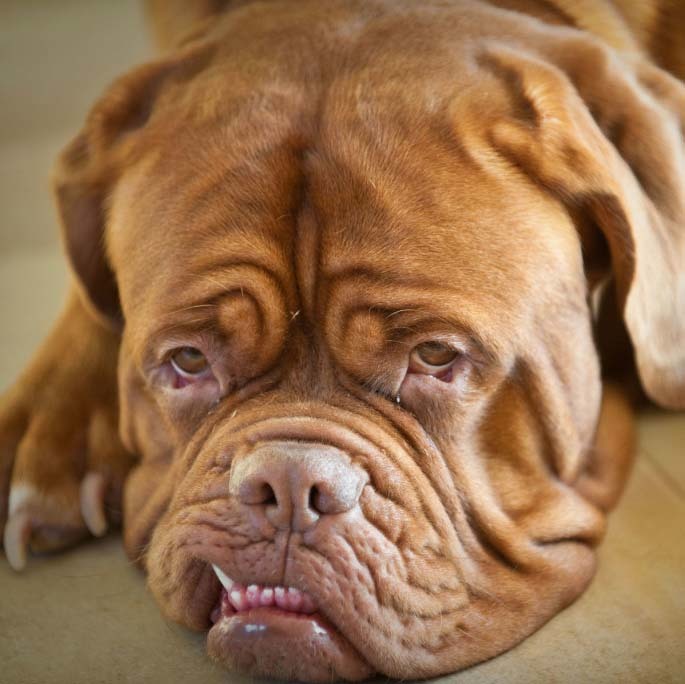What makes the Dogue de Bordeaux Unique?
Given their imposing stature, its’ not surprising that Dogue de Bordeaux are thought to descend from ancient types of mastiffs. Throughout history, members of this breed have served as both livestock and property guardians. Others have herded cattle and pulled carts. While they are definitely a versatile breed, Dogue de Bordeaux are only recommended for experienced owners that can give them the attention they need to be at their best.
Breed Groups
Page Contents
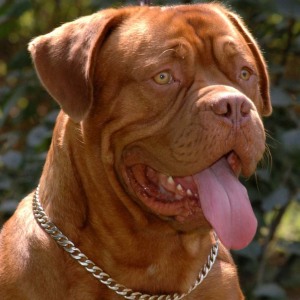
Is the Dogue de Bordeaux Right For You?
Dogue de Bordeaux are placid, easy-going individuals that have proven themselves devoted family members over the centuries. They make wonderful family pets because they are careful around children and get along great with all members of their household. However, members of this fearless breed are rather wary of unfamiliar people. This characteristic serves to make them good watchdogs and their massive size makes them effective guardians.
Dogue de Bordeaux are not recommended for apartment life but they may get along fine in suburban settings if they receive enough exercise. Owner should note that adult members of this breed tend to be calm and well-behaved indoors but puppies can be quite rambunctious. Of course, any dog that receives inadequate amounts of human interaction and exercise is similarly at risk of exhibiting undesirable behaviors.
In 5 Words
- Vigilant
- Devoted
- Even Tempered
- Loyal
- Companionable
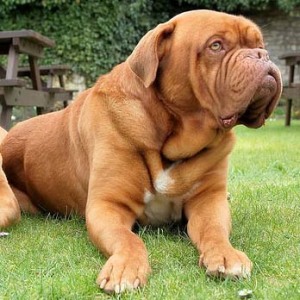
Characteristics
Learn About the Dogue de Bordeaux
Description
General Description
Members of this breed are rather large, muscular dogs with wrinkled faces, enormous heads, thick necks, broad chests, flat noses, and sturdy bodies. Their skin is tough and it hangs loose on their frame. Members of this breed also have an obvious dewlap on their necks. The expression found in their oval eyes is generally a serious one. Dogue de Bordeaux also display black or brown noses with wide nostrils and pendulous black lips. These dogs possess an undershot bite. The ears on this breed are small with somewhat rounded tips and these appendages hang close to their heads. Medium-sized tails that taper to a point are another standard breed feature. Dogs of this breed carry their tails low to the ground. American Kennel Club standards further state that these dogs should have a “harmonious general outline.”
Size
On average, these dogs weigh between 100 and 160 pounds (45 to 72.5 kilograms). They typically stand between 23 and 30 inches (58 and 75 centimeters) tall.
Coat
Members of this breed typically have a short coat with a soft texture. American Kennel Club regulations list fawn, isabella, mahogany, and red colorations as standard for this breed. Dogue de Bordeaux may also have white markings on their toes and chest but not anywhere else on their bodies. Black or brown masks are likewise permitted for members of this breed.
Short History of the Dogue de Bordeaux
As is the case with most dog breeds, the Dogue de Bordeaux’s exact origins are unclear. It is possible that these dogs may have Greek Molossus, Neapolitan Mastiff, Bulldog, Tibetan Mastiff, and/or European Mastiff ancestry in their bloodlines. However, it is more certain that the breed was adapted during the Middle Ages for the violent sports common in that time period such as bear and bull baiting. The French Revolution did minimize the number of available dogs but the breed persevered.
Although these dogs have existed for many centuries, no breed standard was put into place until 1896. However, this did not stop the breed that was to become Dogue de Bordeaux from participating in an 1863 dog exhibition in Paris. Much later, a 1986 movie called Turner and Hooch was at least partially responsible for bringing this breed into the international spotlight. These dogs went on to be officially recognized by the American Kennel Club in 2008.
Temperament
Dogue de Bordeaux are placid, easy-going individuals that have proven themselves devoted family members over the centuries. They make wonderful family pets because they are careful around children and get along great with all members of their household. However, members of this fearless breed are rather wary of unfamiliar people. This characteristic serves to make them good watchdogs and their massive size makes them effective guardians.
Prospective owners should note that these dogs drool and are messy eaters so this breed is not for people who are concerned with keeping their residences immaculate. Snoring can also be problematic. These dogs are also known for their general intolerance of other animals, but most Dogue de Bordeaux will get along fine with pets that they have known since puppyhood. These dogs will also chase any animals that trespass on what they perceive as being their domain.
Dogue de Bordeaux are not recommended for apartment life but they may get along fine in suburban settings if they receive enough exercise. Owner should note that adult members of this breed tend to be calm and well-behaved indoors but puppies can be quite rambunctious. Of course, any dog that receives inadequate amounts of human interaction and exercise is similarly at risk of exhibiting undesirable behaviors.
Caring for Your Dogue de Bordeaux
General Health
Dogue de Bordeaux do not have long lifespans and most only live about 6 years. It is unusual to see a member of this breed that is over 10 years old. Despite that fact, these dogs tend to be fairly healthy. Instances of heart problems, hip dysplasia, hyperkeratosis, and epilepsy have nonetheless been noted from time to time. Some individuals may also have problems with flatulence. Like most short-nosed breeds, Dogue de Bordeaux are prone to overheating in warm weather. It is best if members of this breed live in air conditioned environments. They should also avoid exercise during the middle of the day or in especially hot weather.
Care
Daily
These dogs require several short walks per day even when it is raining or is incredibly cold outside. Having a regular playtime is also recommended. Otherwise, members of this breed tend to be somewhat lazy. Owners will additionally want cleanse their dog’s face after mealtimes to keep dirt and grime from accumulating in the folds.
Weekly
Owners may want to brush out their dog’s coat once a week with a rubber brush to keep their households from becoming covered in fur. It is also important for owners to clean their dog’s teeth a few times per week using a canine toothbrush and vet-approved toothpaste that so that the dog in question maintains good oral health.
Monthly
All dogs will need to have heartworm, flea, and tick prevention medication administered to them on a monthly basis.
Grooming & Bathing
Due to their large stature and their stubborn dispositions, Dogue de Bordeaux are not recommended for inexperienced dog owners. Members of this breed must be properly socialized from a young age to keep them from becoming overly shy or aggressive. Consistent training and a firm hand are the best way to get these dogs to follow commands but they also respond well to edible rewards. Some Dogue de Bordeaux may nonetheless display hostile behavior towards other dogs or dogs of the same gender as that is typical of the breed.
Exercise & Training
Needs lots of exercise. They need to be taken on a daily, long walk. Dogs that lack in mental and/or physical exercise can develop behavior issues.

